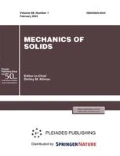Abstract—
The general representation of a symmetric isotropic tensor-function of the second rank in three-dimensional space, depending on two tensor arguments of the second rank, is investigated. This representation includes eight scalar material functions of ten invariants of dependent tensors, including four joint invariants. The tensor function is interpreted as the constitutive relation of an isotropic nonlinear material, which expresses the relationship between deformations and stresses and stress rates. A certain type of stress state is selected, corresponding to a combination of axial tension of the rod by a constant force and (θz) -torsion by a time-periodic moment. It is shown that with a proper selection of the above-mentioned eight material functions as functions of the stress state invariants, it is possible to describe a much stronger change in axial deformations under joint tension and cyclic torsion than under separate tension without torsion. Such an “orthogonal effect” of the stress-strain state is close in form to the ratchetting and vibration creep known in experimental mechanics.
Similar content being viewed by others
REFERENCES
V. V. Lokhin and L. I. Sedov, “Nonlinear tensor functions of several tensor arguments,” J. Appl. Math. Mech. 27 (3), 597–629 (1963).
A. J. M. Spencer, Continuum Physics. Vol. 1, Part III: Theory of Invariants (New York, London, 1971), pp. 239–353.
D. V. Georgievskii, “On potential isotropic tensor functions of two tensor arguments in mechanics of solids,” Mech. Solids 45 (3), 493–496 (2010).
A. A. Il’yushin, Continuum Mechanics (LENAND, Moscow, 2014) [in Russian].
B. D. Annin, “Lagrange-Silvester formula for a tensor function depending on two tensors,” Dokl. Akad. Nauk. SSSR 133 (4), 743–744 (1960).
B. E. Pobedrya, Lections on Tensor Calculus (Mosk. Gos. Univ., Moscow, 1986) [in Russian].
R. V. Goldstein and V. M. Entov, Qualitative Methods in Continuum Mechanics (Wiley, New York, 1994).
Yu. I. Dimitrienko, Nonlinear Continuum Mechanics (Fizmatlit, Moscow, 2009) [in Russian].
D. V. Georgievskii, Selected Problems of Continuum Mechanics (LENAND, Moscow 2018) [in Russian].
D. V. Georgievskii, “On “orthogonal effects” of stress-strain state in continuum mechanics,” Vestn. Kiev Nats. Univ. Ser. Fiz.-Mat. Nauki, No. 3, 114–116 (2013).
D. V. Georgievskii, “The angle between the stress deviator and the strain-rate deviator in a tensor nonlinear isotropic medium,” Moscow Univ. Mech. Bull. 68 (6), 149–151 (2013).
D. V. Georgievskii, “An order of smallness of the Poynting effect from the standpoint of the tensor nonlinear functions apparatus,” Mech. Solids 53 (4), 381–384 (2018).
G. Wertheim, “Me′moire sur la torsion. Premi re Partie,” Ann. Chim. Phys. Ser. 50, 195–321 (1857).
J. H.Poynting, “On the changes in the dimensions of a steel wire when twisted, and on the pressure of distorsional waves in steel,” Proc. Roy. Soc. London. A 86, 534–561 (1912).
A. E. Green, “A note on second-order effect in the torsion of incompressible cylinders,” Proc. Cambridge Philos. Soc. 50 (3), 488-490 (1954).
R. C.Batra, F. dell’Isola, and G. C. Ruta, “Generalized Poynting effects in prismatic bars,” J. Elasticity 50 (2), 181–196 (1998).
A. Akinola, “An energy function for transversely isotropic elastic material and the Poynting effect,” Korean J. Comput. Appl. Math. 6 (3), 639–649 (1999)
V. F. Astapov, A. A. Markin, and M.Y. Sokolova, “Torsion of a solid cylinder made of isotropic elastic material,” Izv. Tul’skogo Gos. Univ. Ser. Mat. Mekh. Inf. 5 (2), 43–48 (1999).
T. V. Gavrilyachenko and M. I. Karyakin, “Specific features of the nonlinearly elastic behavior of cylindrical compressible bodies in torsion,” J. Appl. Mech. Tech. Phys. 41, 377–381 (2000).
B. M. Malyshev, “A plastic flow under combined continuous extension and torsion under the action of small torsional moments,” Vestn. MGU. Ser. Mat. Mekh. Astron. Fiz. Khim., No. 1, 55–68 (1958).
B. M. Malyshev, “Tube twisting under stepwise change of the torsional moment in the process of continuous extension,” Vestn. MGU. Ser. Mat. Mekh. Astron. Fiz. Khim., No. 2, 33–46 (1958).
R. A. Vasin, O. I. Bylya, and P. V. Chistyakov, “On some trends in retchetting research,” Vestn. MGU. Ser. 1 Mat. Mekh., No. 4 (2020) (in press).
A. M. Lokoshchenko, “Vibrocreep of Metals in Uniaxial and Complex Stress States,” Mech. Solids 49 (4), 453–460 (2014).
Funding
This work was carried out within the framework of the state assignment AAAA-A20-120011690136-2 with the support of the Russian Foundation for Basic Research (grant nos. 18-29-10085mk, 19-01-00016a).
Author information
Authors and Affiliations
Corresponding author
Additional information
Translated by M. Katuev
About this article
Cite this article
Georgievskii, D.V. Nonlinear Tensor Functions of Two Arguments and Some “Orthogonal Effects” of the Stress–Strain State. Mech. Solids 55, 619–623 (2020). https://doi.org/10.3103/S0025654420300020
Received:
Revised:
Accepted:
Published:
Issue Date:
DOI: https://doi.org/10.3103/S0025654420300020


